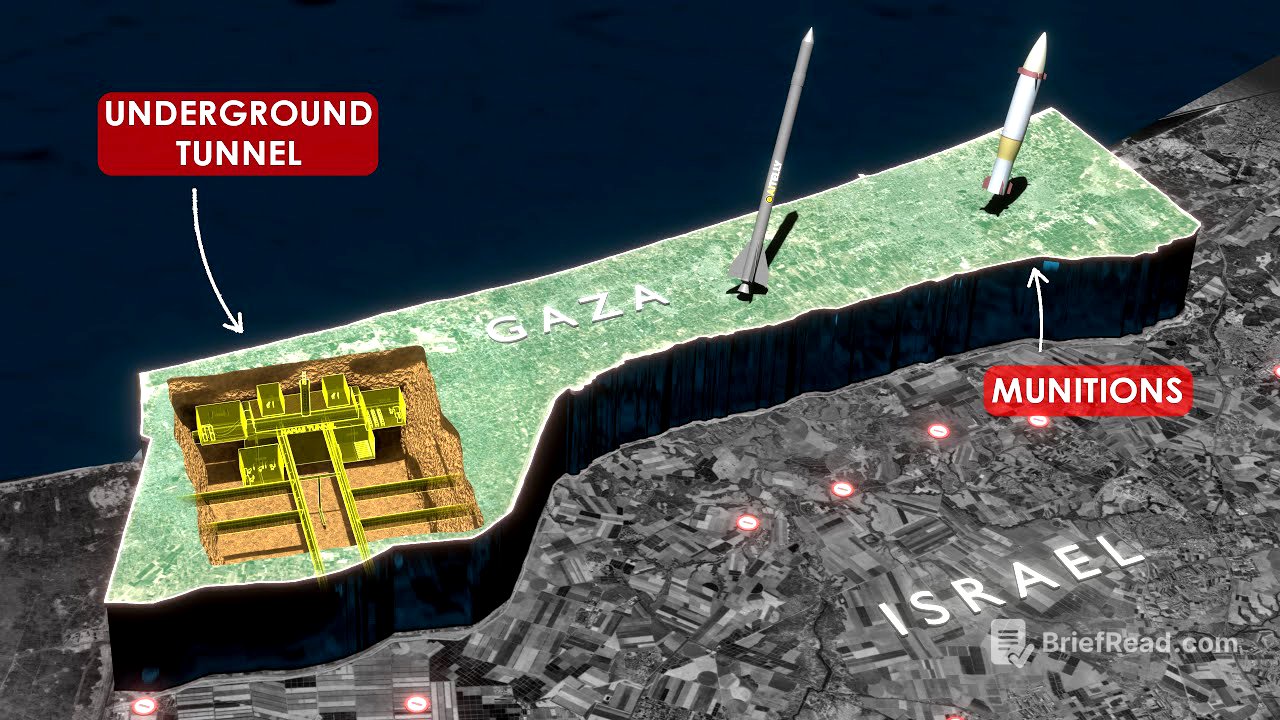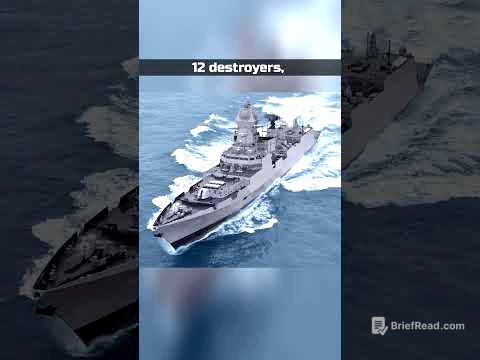TLDR;
This video examines Hamas's evolving military strategies in Gaza following the October 7th attacks and Israel's subsequent military campaign. It details Hamas's shift to decentralised guerilla warfare, their continued weapon production using salvaged materials, and the strategic importance of their extensive tunnel network. The video also covers how Hamas maintains governance by controlling aid distribution, their focus on short-range attacks, and the rising discontent among the civilian population. Finally, it explains the construction and strategic use of Hamas's tunnel system, including its various levels and functions.
- Hamas has shifted to decentralised guerilla warfare tactics.
- They continue to produce weapons using salvaged materials and unexploded ordnance.
- The tunnel network remains a crucial element of their military strategy.
Introduction: Hamas's Shift in Military Strategy [0:00]
Following the October 7th attacks, Israel launched a military campaign in Gaza aimed at dismantling Hamas. Despite sustained bombardment, Hamas continues to fight, having shifted from traditional battlefield tactics to a decentralised, insurgent-style warfare. This involves small, autonomous units operating independently, making them harder for Israeli forces to detect. Guerilla tactics such as ambushes, sniper fire, IED attacks, and hit-and-run raids have become the standard methods of engagement, utilising Gaza's urban landscape to strike and quickly disappear. This decentralised structure ensures continued operations even if senior leaders are lost.
Weapon Production and Resourcefulness [1:15]
Despite the destruction of much of its weapons manufacturing infrastructure, Hamas has managed to salvage and repurpose equipment. Tools and components recovered from damaged tunnels and factories have allowed limited production to resume. They are rebuilding rockets, anti-tank missiles, and IEDs. Unexploded Israeli munitions are often converted into makeshift explosives for IEDs to create psychological warfare. Even under Israeli military oversight, short-range rockets are still being fired from within Gaza to create chaos.
The Tunnel Network: A Cornerstone of Hamas's Strategy [1:57]
Hamas's tunnel network remains a crucial element of its strategy. Although Israeli forces have destroyed a significant portion of the tunnels, Hamas still retains hundreds of miles of underground passages. These tunnels are used to move personnel, store weapons, and launch ambushes, enabling hit-and-run attacks and the deployment of anti-tank missiles. This allows them to avoid direct confrontations with Israel's superior military forces, relying instead on ambushes, IEDs, and targeted strikes.
External Support and Governance [2:43]
External support remains a crucial part of Hamas's military strategy. With traditional smuggling routes through Egypt heavily disrupted, the group has become increasingly reliant on Iranian technical assistance and weapon designs to sustain local production of drones and rockets. Even amid the war, Hamas maintains a degree of governance by controlling the distribution of humanitarian aid, diverting some resources to its own ranks to secure loyalty and present itself as a stabilising force.
Survival Phase and Challenges [3:12]
Strategically, Hamas has entered a survival phase. With most of its long-range rocket arsenal depleted, the focus has shifted to short-range attacks and psychological tactics like intermittent rocket fire near border areas. However, the group faces serious obstacles, including the near exhaustion of advanced weapon stockpiles, forcing them to rely on cruder arms. Discontent is also rising among the civilian population.
Improvised Rocket Construction [3:40]
Hamas utilises simple methods to construct rockets using common household ingredients such as sugar and potassium nitrate (fertiliser). The process involves melting sugar, mixing in the fertiliser, and pouring the mixture into a mold to form a propellant slug. This propellant is placed into a round tube, typically made from locally available water pipes. The sugar provides energy, while the fertiliser acts as an oxidising agent, allowing for a quicker release of energy. Rockets are launched from a simple steel frame, and a wire connected to a battery ignites the solid fuel propellant. After the burn, the rocket follows a predictable trajectory, and a fuse sets off the warhead, creating an explosion and dispersing shrapnel.
Guerilla Warfare Tactics and Tunnel Strategy [4:58]
Hamas employs a guerilla warfare strategy utilising its extensive tunnel network for quick hit-and-run tactics. They emerge from tunnels with anti-tank RPGs, targeting vehicles like the Marava. To counter the Marava's trophy system (which neutralises incoming threats), they fire RPGs at very close range or target the vehicle's weaker rear armour. Another tactic involves hitting tanks with RPGs just below the turret to damage or immobilise them.
The Structure and Functionality of Hamas's Tunnel System [6:08]
Hamas's tunnel network comprises an estimated 1,300 tunnels spanning approximately 500 km, reaching depths of up to 70 metres. The tunnels, typically 2 metres high and 2 metres wide, are structured in multiple layers, creating a "metro" system hidden within city buildings. Level one includes the entrance and a launch pad for rockets. Level two features a reinforced tunnel with concrete blocks for support. Level three requires oxygen, supplied by generators or ventilators. Level four serves as a meeting room and sleeping quarters. Level five is another reinforced tunnel supporting a base. Level six functions as a weapon storage facility to prevent cookoffs, while level seven stores explosive materials with sealed doors to mitigate accidental explosions. Level eight houses the control and command centre, utilising landline phones for offline communication to prevent hacking.









